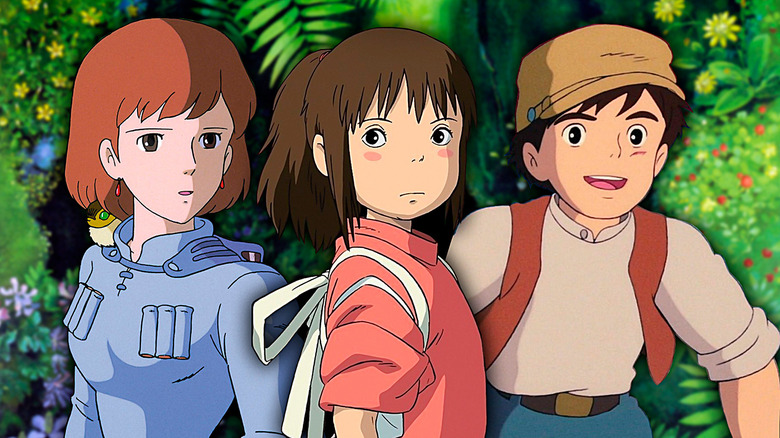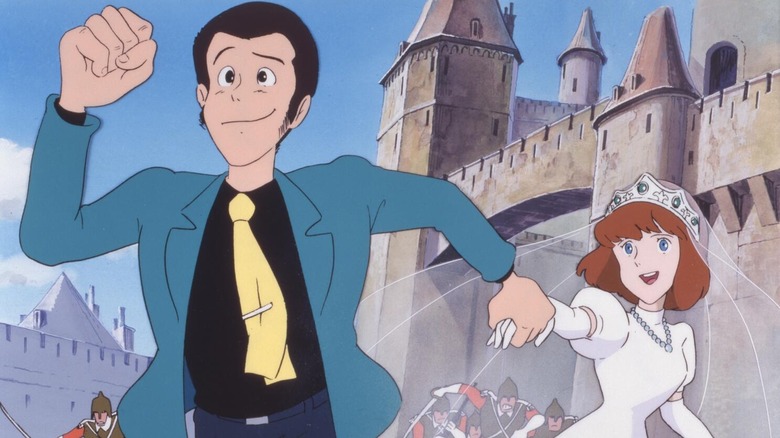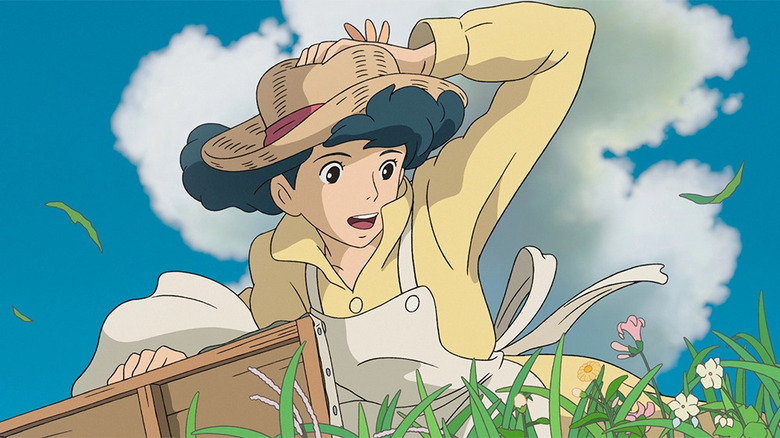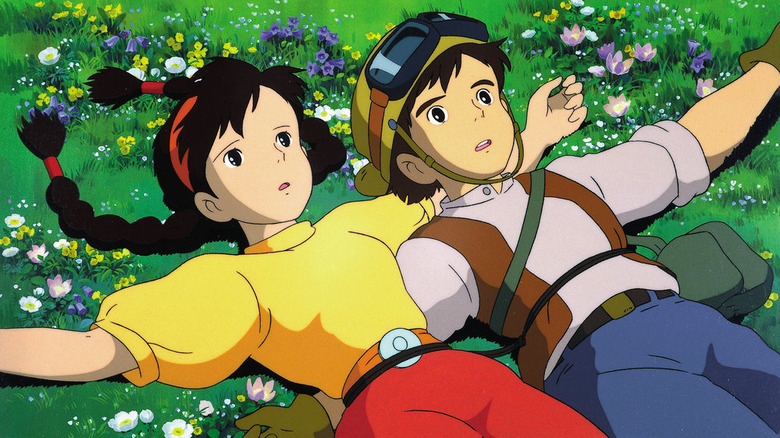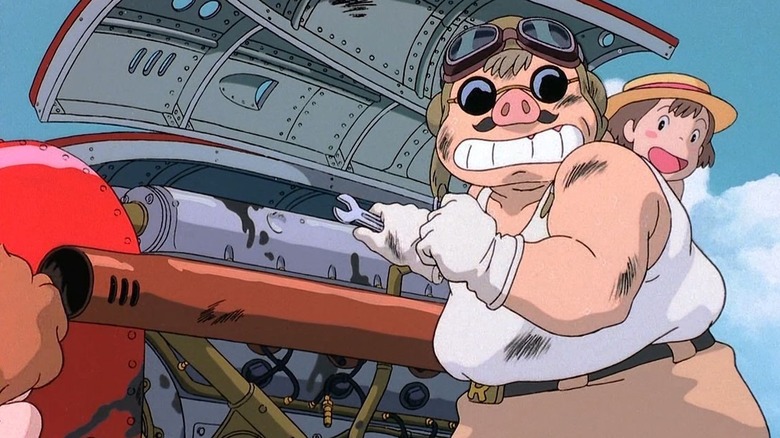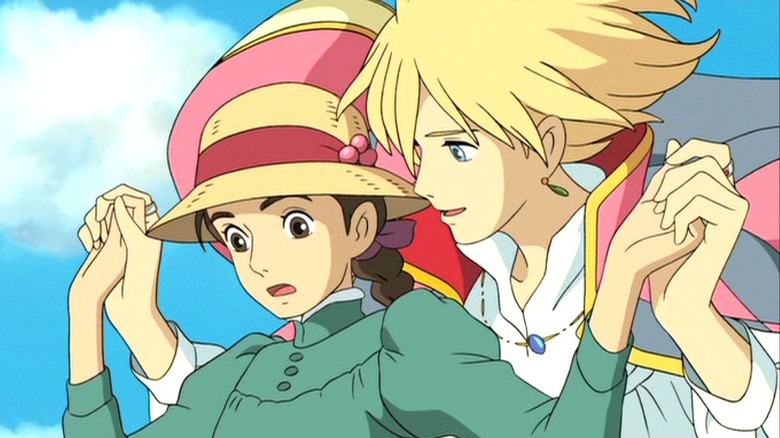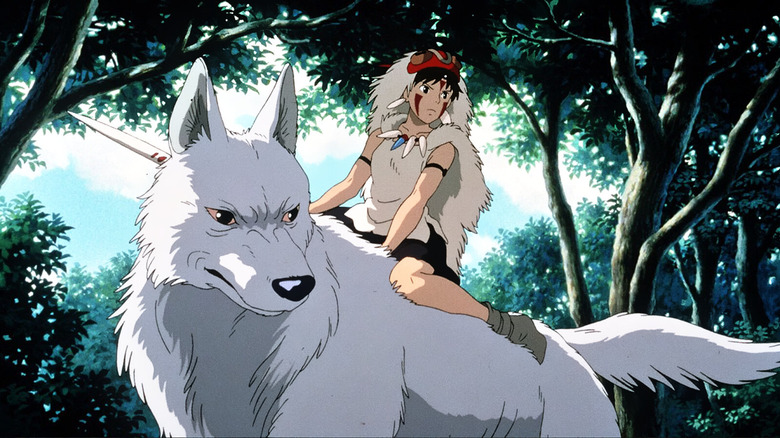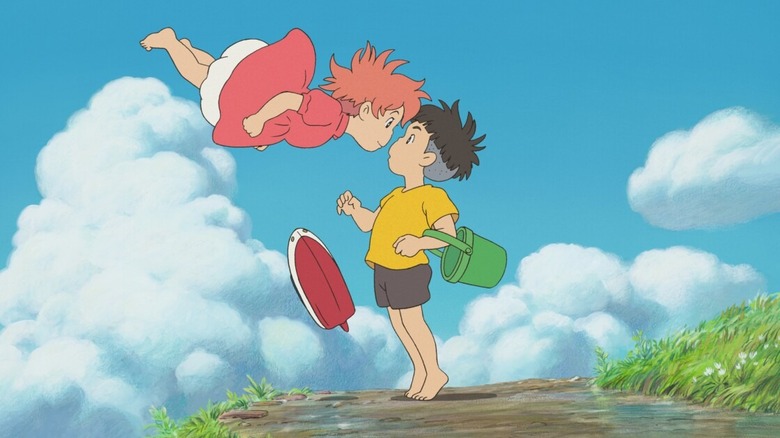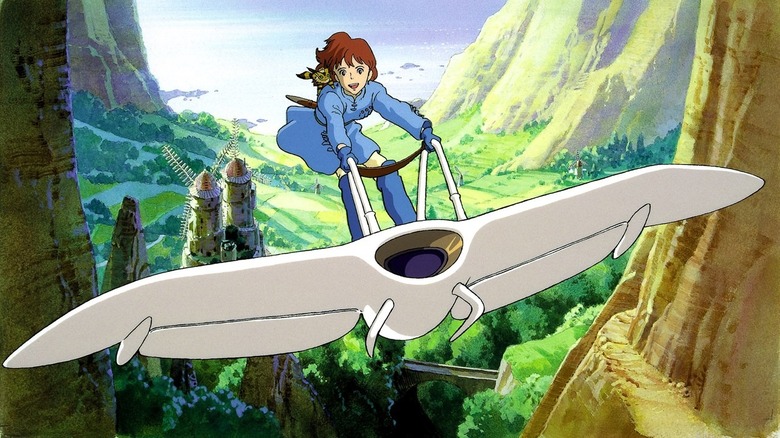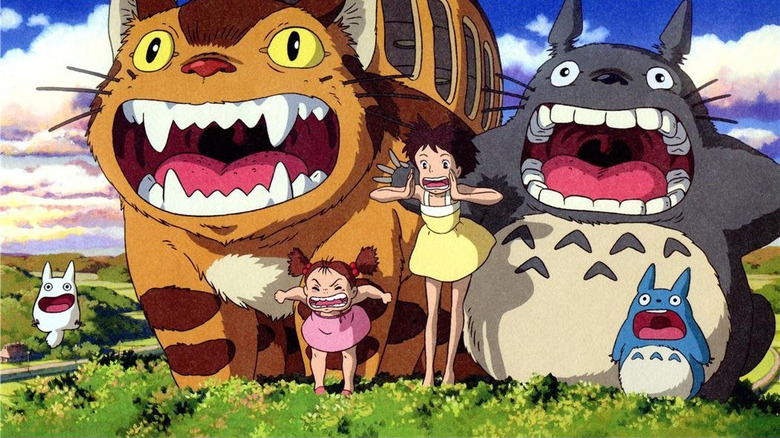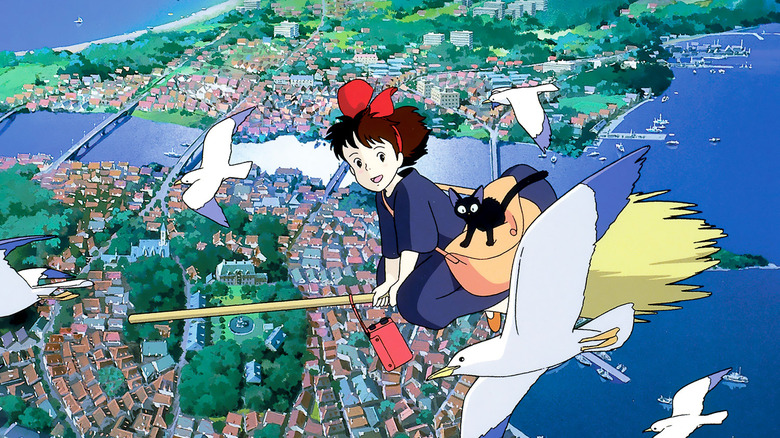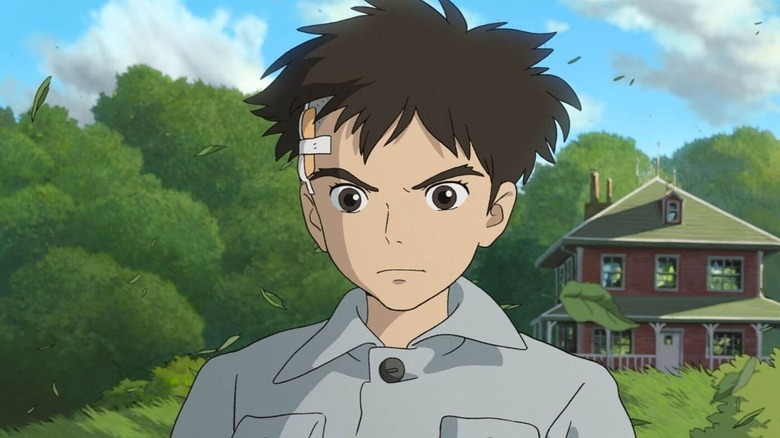Every Hayao Miyazaki Movie, Ranked
A true auteur, Hayao Miyazaki is a master of storytelling and the godfather of modern anime. A rare writer-director who has arguably never made a bad film, his catalog of work boasts more critically acclaimed classics than many of Hollywood's greatest filmmakers. While he got his start working on TV favorites like "Lupin the Third" and "Future Boy Conan," it was when he made the transition to the big screen that Miyazaki began his road to becoming a legend.
At one point or another, many of Miyazaki's films have been hailed as the greatest animated films of all time, whether it's by a fellow acclaimed director, a major entertainment outlet, or a qualified critic. For many, it may be tough to sort out his filmography and say which is better than the last, and if you were to ask a dozen Miyazaki fans to rank them, you'd probably get a dozen different answers. But we don't shy away from a challenge, and we're giving a shot at a definitive ranking of the works of Hayao Miyazaki, using audience reactions on social media, fan lists, and scores from IMDb, Metacritic, and Rotten Tomatoes.
Lupin III: The Castle of Cagliostro (1979)
On a list of ranked movies, someone has to be last. But when it comes to Hayao Miyazaki, the "worst" is relative, because at the bottom of the list is "Lupin III: The Castle of Cagliostro, a movie few would ever consider anything less than great. A stellar animated adventure that might top the list if it were from any other anime director, "Cagliostro" is an extension of "Lupin the Third," an anime TV series from the early '70s on which Miyazaki directed a number of episodes.
Lupin (Yasuo Yamada) is a classic thief with a heart of gold, who discovers that his latest score is nothing but counterfeit cash. Looking to find the real money, he finds himself before Count Cagliostro, who has kidnapped the young princess Clarissa (Sumi Shimamoto) intending to make her his wife whether she likes it or not — and Lupin leads a team of adventurers to rescue her.
Released in 1979, "The Castle of Cagliostro" was Miyazaki's first feature film and showcased his skills like never before, even if it's a little rough around the edges compared to his later efforts. Longtime "Lupin" fans, meanwhile have taken issue with some of the changes he made to the character, which turned the cavalier anti-hero into something of a bumbling fool. Though it wasn't a major success at the time, later re-releases raised its profile, and while it's at the bottom of our list, its impact is undeniable, with Steven Spielberg calling it one of the greatest action movies of all time.
The Wind Rises (2013)
Released in 2013, "The Wind Rises" was Hayao Miyazaki's first film since "Ponyo" in 2008. It's also the first and only film he's made based on a real-life figure, following the early days of revolutionary Japanese aircraft designer Jiro Horikoshi, who created some of the most ingenious aircraft designs in history. It's a story of love and ambition, but also something of a pacifist manifesto from Miyazaki.
In this heavily fictionalized retelling of Horikoshi's formative years, Jiro meets a young woman named Nahoko who he loses touch with just before going to work as an aeronautical engineer. After numerous setbacks in his radical new aircraft designs, Jiro is dispirited but gets inspiration in the form of dreams of his engineering idol, Giovanni Battista Caproni. Torn between his love of airplanes and his government's plans to use them for destruction, Jiro is uplifted when he reunites with Nahoko. But things take a turn when his new love is stricken with a debilitating disease.
A somber, moving tale, "The Wind Rises" garnered criticism from some in the Japanese government over Miyazaki's anti-military message, but the movie still stands as a testament to powerful storytelling. Some critics lauded the changes that Miyazaki made to history, and as usual, it was heaped with praise for its luscious animation. Critics of the film, though, felt it was a bit of a letdown after "Ponyo" — particularly as it was billed as Miyazaki's final film — with a story that lacked stakes, relying almost entirely on Miyazaki's (admittedly considerable) charm.
Castle in the Sky (1986)
Released in 1986, "Castle in the Sky" was Hayao Miyazaki's first official film for Studio Ghibli, the legendary movie studio that has been his home for features ever since. An early work that helped establish the steampunk genre, "Castle in the Sky" mixes high fantasy with industrialism in a story that mostly takes place in the air. Heroes in high-flying planes, villainous sky pirates, and a mythical floating castle all combine to craft an extraordinary animated adventure like no other.
Inspired by a trip Miyazaki took to Wales not long after the 1984 miner's strike, "Castle in the Sky" tells the story of Pazu, a young man who seeks a legendary island in the sky that his father called Laputa. During his search, though, Pazu stumbles across an orphan named Sheeta, who carries a strange magical crystal. But Sheeta is being hunted by a government agent and an air outlaw gang, and the pair soon find themselves seeking refuge in a series of subterranean tunnels. There they meet Uncle Pom, who knows all about the crystal — which is being mined underground — and it could be key to locating Laputa and finding justice for Pazu's father.
Full of awe-inspiring visuals and a tender love story amid an epic fantasy quest, "Castle in the Sky" is a wondrous cinematic treat that soars when it focuses on its characters. Some, however, felt that the story loses focus and drags at times, contributing to its overlong runtime that irked some reviewers.
Porco Rosso (1992)
Based on the manga "Hikotei Jidai" — which translates to "The Age of the Flying Boat" — the 1992 feature "Porco Rosso" takes its name from the story's lead character, a pilot and bounty hunter who has the head of a pig. Set in the late 1920s in Italy, the film centers on Rosso's quest to win the heart of the lovely Gina, who becomes the object of affection for a rival pilot.
A wanted man in his native Italy, Rosso becomes the target of the rising fascist government. They have been employing flying pirates who are hunting him, including an American ace named Curtis, a deadly shot who is more than up to the challenge. But Porco doesn't just find himself a new enemy who wants him dead — he also finds himself fighting for the love of Gina, with whom Curtis becomes enamored.
Through the lens of real-life European history, Hayao Miyazaki tells a story that pays homage to pulpy classic adventure stories with a focus on friendship and plenty of humor and heart. Manga-style action and the expected beauty of Miyazaki's stunning direction overcome its fairly rote plot, demonstrating what a master of animated storytelling he really is.
Howl's Moving Castle (2004)
In the mid-1980s when British author Diana Wynne Jones first wrote the fantasy novel "Howl's Moving Castle," she had no way of knowing that it would one day become one of the most beloved anime movies of all time. That was thanks to Hayao Miyazaki, who took the reins on the project after the turn of the millennium and was inspired by the book's fantastical imagery, combined with his clear love of castles.
Set in a modern-day world that's been fused with magic and fantasy, "Howl's Moving Castle" introduces us to Sophie, a young woman living in a kingdom that is in bitter conflict with its neighbor and rival. But when Sophie is cursed to become an old woman, she makes a deal with a fire demon named Calcifer to return her to her youthful body. Calcifer is a servant of the wizard Howl who resides in his strange moving castle. But once there, Sophie is caught up in the great war between the kingdoms.
Famously influenced by Miyazaki's opposition to the invasion of Iraq in the early 2000s, "Howl's Moving Castle" wasn't well-received initially, with Roger Ebert awarding it just two-and-a-half stars. Nevertheless, it's since become one of the director's crowning achievements, another imaginative adventure in a wistful world of timeless wonder, and many fans still feel that it's his best work.
Princess Mononoke (1997)
Hayao Miyazaki loves history and fantasy, and his movies often marry the two. "Princess Mononoke" does this brilliantly, taking place during Japan's Muromachi period in the 14th and 15th centuries when the shogun imperialists ruled. A movie that dips into mythology, "Princess Mononoke" is less the wizards and dragons sort of fantasy and more the gods and monsters kind. This time, Miyazaki pits the lords of all creation against the people of a small Japanese village who defy the order of the natural world.
In the village of Emishi, Prince Ashitaka is cursed by a nefarious demon, which causes him tremendous pain but also grants him inhuman super strength. Now on a journey to break his curse, Ashitaka meets a number of allies on his way westward where the demon calls home and a cure can be found. But he also meets a number of ancient gods: The Great Forest Spirit, the wolf goddess Moro, and the boar god Nago. He also meets San — known as Princess Mononoke — who has been raised among the wolves and despises mankind for using up the forest's precious resources.
A fantasy war epic, "Princess Mononoke" has a lot to say about mankind's treatment of nature. But it's also a sumptuous visual spectacle that pulls together every weapon in Miyazaki's arsenal, from his impeccable directing to his penchant for rich world-building. The film is an all-time classic and has been cited by James Cameron as an influence on "Avatar."
Ponyo (2008)
After the landmark "Howl's Moving Castle" and the genre-shattering "Spirited Away," Hayao Miyazaki returned in 2008 to complete a string of three all-time greats with "Ponyo." For the film, Miyazaki and Studio Ghibli decided to turn to a new, bolder animation style they'd perfected on a series of shorts that focused on simplistic linework that could achieve results that more highly rendered work couldn't. To tell the story, Miyazaki spent time researching coastal towns in Japan and found inspiration halfway around the world in a British art museum and the work of both Hans Christian Anderson and painter John Everett Millais.
"Ponyo" is an underwater tale centered on a goldfish princess named Brunhilde. Breaking her people's laws, Brunhilde heads above the waves to the human town where she meets a boy named Sosuke, who dubs her "Ponyo," and the two become fast friends. After helping to heal Sosuke when he is injured, though, Ponyo begins to slowly transform into a human, and the more time that Ponyo spends on the surface away from the water, the more she wishes to remain there forever. When her father comes to bring her home, however, Ponyo accidentally puts the entire village in danger.
A delight for families, kids, and adults of all ages, "Ponyo" may not be Miyazaki's best, but it might be his most timeless and accessible. An easy entry point for those unfamiliar with his work, it takes hallmarks of animated classics like "The Little Mermaid," "Finding Nemo," and "Cinderella," and adds the iconic director's own unique style to become something truly special.
Nausicaä of the Valley of the Wind (1984)
Set in a post-apocalyptic world where giant insects roam a ruined world run by an iron-fisted empire, "Nausicaä of the Valley of the Wind" seems inspired by classic works of science fiction. And while Hayao Miyazaki has never said outright that the work of Frank Herbert's "Dune" had any influence on him, the similarities are obvious. Yet the iconic director does something entirely different with his tale, putting forth an inspiring, hopeful adventure with an uplifting spirit, contrary to typical works of dystopian sci-fi.
In the desolate wasteland that remains of Earth — brought down by a great war — we meet Nausicaä, a fierce young woman who lives in the Valley of the Wind. The region borders the Toxic Jungle, home to a race of giant mutated insects called the Ohmu. While Nausicaä is able to communicate with the oversized insects, most see them as vicious beasts, so when warring factions threaten the jungle, they have no qualms about driving the Ohmu to extinction. It's up to Nausicaä to save the Ohmu, whose very existence is key to keeping nature in balance.
Perhaps Miyazaki's most underrated film, "Nausicaä Of The Valley Of The Wind" often doesn't get the same amount of attention as his other beloved classics, but is no less enthralling or impressive as a production. A seminal work that mixes sci-fi and fantasy, it transcends anime and earns its place among the best of all three genres.
My Neighbor Totoro (1988)
Among Hayao Miyazaki's most famous animated features — thanks to its iconic title character, who by no coincidence is eminently merchandisable — "My Neighbor Totoro" is as quintessential an '80s anime as there is. It features one of the genre's most recognizable icons in the titular Totoro, a giant ball of fuzz with an enormous mouth, and his best human friends, sisters Satsuki and Mei.
It's the 1950s in Japan in "My Neighbor Totoro" where we meet Professor Tatsuo Kusakabe and his daughters. They've just moved into a new home which Satsuki and Mei quickly learn is also the residence of a group of house spirits known as Susuwatari. They are hard to see, but when Mei discovers one, she names it Totoro, believing it's a character from her favorite book. The two girls become best friends with the spirit animal Totoro, who introduces them to the wonders of his own magical world.
Since its 1988 release, the titular Totoro has become a Japanese cartoon mascot akin to the likes of Winnie the Pooh or Garfield. But the movie is more than just its adorable title character, it's also a moving story of friendship and one of the finest animated efforts out of Japan in the '80s, if not the very best. It's a charming story that's impossible not to love, and the film that made Miyazaki a sensation outside of his native Japan.
Kiki's Delivery Service (1989)
In the 1980s, Hayao Miyazaki's directorial efforts just kept getting better and better. And they culminated with the best of them all, the 1989 fantasy "Kiki's Delivery Service," just a year after "My Neighbor Totoro." This time, the setting is directly magical, with the film's hero a young witch named Kiki who, accompanied by her talking black cat Jiji, starts her own mail service by air — thanks to her flying broom.
A sweet and endearing story about a young woman on her own, "Kiki's Delivery Service" isn't the sprawling epic of "Nausicaä of the Valley of the Wind" nor the action-adventure of "Princess Mononoke." Instead, it's almost a slice-of-life story, with the young witch on various adventures delivering items to different locations. Kiki's friend Osono, meanwhile, tries to set her up with a boy named Tombo — a budding aviation lover who is working on his own flying machine.
When it comes to Hayao Miyazaki films, it starts to become repetitive when talking about what makes them great — with their strong storytelling, delightful characters, wildly imaginative worlds, and gorgeous animation. Nevertheless, "Kiki's Delivery Service" stands out above most in his catalog by being nearly pitch-perfect in all of those ways, and there's every reason for fans to count it as his very best.
The Boy and the Heron (2023)
Throughout his career, Hayao Miyazaki has announced his retirement from filmmaking on several occasions. In 2013, he did it again after the release of "The Wind Rises," and this time it seemed like it might be for real: By 2022, all he'd produced was a single short, "Boro the Caterpillar." But then came his triumphant return to filmmaking a year later with "The Boy and the Heron." While the film shares its title with a 1937 novel, it's actually an original story from Miyazaki.
Another film to be set around WWII, "The Boy and the Heron" takes place at the tail end of the conflict in 1943, and centers on Mahito Maki, whose father takes him to the countryside after his mother Hisako is killed in Tokyo. Mahito struggles to accept his new stepmother — Hisako's younger sister Nasuko — especially after she becomes pregnant. But Natsuko goes missing, a talking heron visits Mahito and tells him that his mother is still alive, and alongside his stepmother, is being held in a great tower that takes him to a strange and wondrous new realm.
Already being praised as a new Miyazaki classic, "The Boy and the Heron" was met with critical acclaim. The Times UK called it a new masterpiece, with a lavish look and a gut-wrenching story of loss that demonstrates just how great Miyazaki can be — and that a decade on the outside looking in hasn't dulled him one bit.
Spirited Away (2001)
While it's not easy to rank the films in Hayao Miyazaki's catalog because they're all so good, the top spot isn't really up for much debate. Most fans of all stripes would probably agree that Miyazaki's best work is "Spirited Away," a groundbreaking anime fantasy from 2001 that blends together all of the best parts of his earlier films and somehow elevates them to a genre-shaking masterwork.
The film is something of an amalgamation of other stories, about a young girl named Chihiro who moves to a new home and becomes drawn into a mystical world of spirits. While there, Chihiro's parents are magically turned into pigs, and it's up to her to save them and find a way to return to her own world. To do it, she goes to work in a bathhouse and encounters the masked spirit known as No-Face. But when she is given a new name by the witch Yubaba, it's a race against time to find a way home before she forgets her old life forever.
A jaw-dropping movie that will enchant anyone who watches it, "Spirited Away" will transport viewers — mind and soul — into another realm themselves. Dazzling with animation that will impress even the most seasoned anime fans, it's a true work of art that audiences have been putting on a pedestal since the day it was released.
